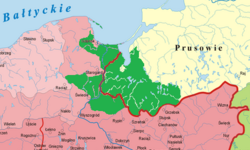Vėtuhapamarėska: Difference between revisions
Jump to navigation
Jump to search
(Created page with "{{Infobox language |image= POMORZE_2016.png |imagesize= 250px |name= ''Old Pomorian language'' |nativename=''(Vėtuhapamarėska gålba)'' |pronunciation=/ˈʋeː.tʊ.ɦɑ.pɑ....") |
No edit summary |
||
| Line 1: | Line 1: | ||
{{Infobox language | {{Infobox language | ||
|image= | |image= POMORZE_XII-copy.png | ||
|imagesize= 250px | |imagesize= 250px | ||
|name= ''Old Pomorian language'' | |name= ''Old Pomorian language'' | ||
| Line 25: | Line 25: | ||
Usually Old Pomorian refers to a period from the VIIth to the late XIIIth centuries. During it Old Pomorian was spoken on a large territory of Northern Poland and South-Western Prussia. | Usually Old Pomorian refers to a period from the VIIth to the late XIIIth centuries. During it Old Pomorian was spoken on a large territory of Northern Poland and South-Western Prussia. | ||
[[File:POMORZE_XII.png|450px|thumb|left|The area marked in green represents Pomorian majority on the territory in the XIIth-XIIIth centuries]] | |||
[[Category:Pamarėska]] | [[Category:Pamarėska]] | ||
Revision as of 16:53, 23 August 2017
| Old Pomorian language | |
|---|---|
| (Vėtuhapamarėska gålba) | |
 | |
| Pronunciation | [/ˈʋeː.tʊ.ɦɑ.pɑ.ˈma:.reː.skɑ/] |
| Created by | Raistas |
| Setting | Parallel World |
Indo-European
| |
Early forms | |
The Old Pomorian (Vėtuhapamarėska gålba in Pomorian) is a Balto-Slavic language which is a direct ancestor of modern Pomorian. It's own ancestor could possibly be Proto-Balto-Slavic itself, but because the language shares many common sound changes and vocabulary with Proto-Slavic most scholars agree that the Pomorian language descends from a dialect of Early Proto-Slavic.
Usually Old Pomorian refers to a period from the VIIth to the late XIIIth centuries. During it Old Pomorian was spoken on a large territory of Northern Poland and South-Western Prussia.
